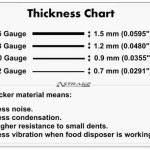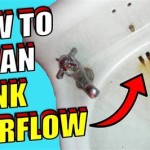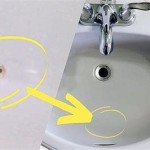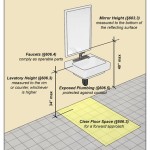Stopper Stuck in Kitchen Sink
A stuck stopper in a kitchen sink can disrupt daily routines and potentially lead to drainage issues. Understanding the different types of sink stoppers and their mechanisms can help in troubleshooting and resolving this common household problem.
Kitchen sink stoppers typically fall into a few main categories: pop-up stoppers, lift-and-turn stoppers, and push-and-seal stoppers. Each type has its own unique design and method of operation, which influences the approach needed when the stopper becomes stuck.
Pop-up Stoppers: These stoppers are connected to a pivot rod, a long metal piece extending down from the back of the faucet. The pivot rod, when raised or lowered, controls the vertical movement of the stopper. A clevis strap, a small nut-like piece, secures the pivot rod to the stopper. Over time, hair, soap scum, or mineral buildup can accumulate around the stopper and pivot rod assembly, hindering its movement.
To fix a stuck pop-up stopper, first try to remove the stopper. Locate the clevis strap under the sink. Depending on the model, this may require loosening a screw or simply unclipping the strap. Once disconnected, the stopper can be lifted out of the sink drain. Clean the stopper thoroughly, removing any debris. Clean the drain opening as well. Reconnect the stopper and pivot rod, ensuring the clevis strap is securely fastened. Test the stopper to verify proper functionality.
If the stopper remains stuck after cleaning, the issue might be with the pivot rod itself. Disconnect the pivot rod from the clevis strap underneath the sink. Inspect the rod for any signs of corrosion or damage. Attempt to move the rod up and down. If it moves freely, the problem likely lies with the stopper mechanism. If the rod is stuck, it may need to be replaced.
Lift-and-Turn Stoppers: These stoppers operate by rotating the top portion of the stopper to lift and lower it. These are simpler mechanisms than pop-up stoppers and are less prone to issues. However, they can still become stuck due to debris buildup.
Resolving a stuck lift-and-turn stopper is usually straightforward. Unscrew the top portion of the stopper by turning it counterclockwise. This will allow you to lift the entire stopper assembly out of the drain. Clean the stopper and the drain opening thoroughly. Replace the stopper assembly by inserting it into the drain and turning the top clockwise to secure it. Test the stopper’s movement to ensure it is functioning correctly.
Push-and-Seal Stoppers: These stoppers operate with a simple push-to-seal, push-to-release mechanism. They are generally less prone to getting stuck than other types. However, buildup around the edges can sometimes create resistance.
If a push-and-seal stopper becomes difficult to operate, clean the rim of the stopper and the drain opening where the seal is made. A buildup of soap scum or mineral deposits can interfere with the sealing action. If cleaning does not resolve the issue, the stopper may need to be replaced due to wear and tear of the sealing mechanism.
Preventing Stuck Stoppers: Regular maintenance can help prevent future issues with stuck stoppers. Avoid pouring grease or oil down the drain, as these can solidify and contribute to clogs. Periodically clean the stoppers and drains with a mixture of baking soda and vinegar. This helps to break down soap scum and mineral deposits. Running hot water down the drain after each use can also help prevent buildup.
Further Troubleshooting: If the stopper remains stuck after attempting these solutions, there may be a more complex issue, such as a blockage further down the drainpipe. In such cases, it may be necessary to use a plunger or a plumber's snake to dislodge the blockage. If these methods are unsuccessful, or if the problem recurs frequently, it is recommended to contact a qualified plumber to investigate the issue.
Safety Precautions: When working under the sink, always take necessary safety precautions. Turn off the water supply to the faucet before attempting any repairs. Wear appropriate eye protection and gloves to protect against potential hazards. If using chemical drain cleaners, follow the manufacturer's instructions carefully and ensure adequate ventilation.
Understanding the specific type of stopper in your kitchen sink is essential for effectively addressing a stuck stopper. By following the appropriate troubleshooting steps and performing regular maintenance, you can keep your sink draining smoothly and avoid the inconvenience of a stuck stopper.

Plumbing How Can I Remove The Stopper From My Sink Home Improvement Stack Exchange

How To Remove A Kitchen Sink Stopper That Is Stuck Youtube

How To Remove A Stuck Sink Stopper

How To Fix Sink Stopper Stuck Open And Close Positions

How Do I Remove Kitchen Sink Drainer Basket Without A Visible Lock Nut Home Improvement Stack Exchange
I Ve Twisted Pulled And Jimmied This Sink Drain Stopper But It Won T Come Out The Silver Lid Also How Can Get Without Breaking Quora

Universal Kitchen Sink Strainer Stopper For Garbage Disposals Kraus

How To Remove A Stuck Sink Stopper

Is Your Sink Drain Stopper Stuck We Know How To Fix It Clover Contracting

Drain Sink Strainer Rotates To Stopper Position When Water Is Running Home Improvement Stack Exchange







